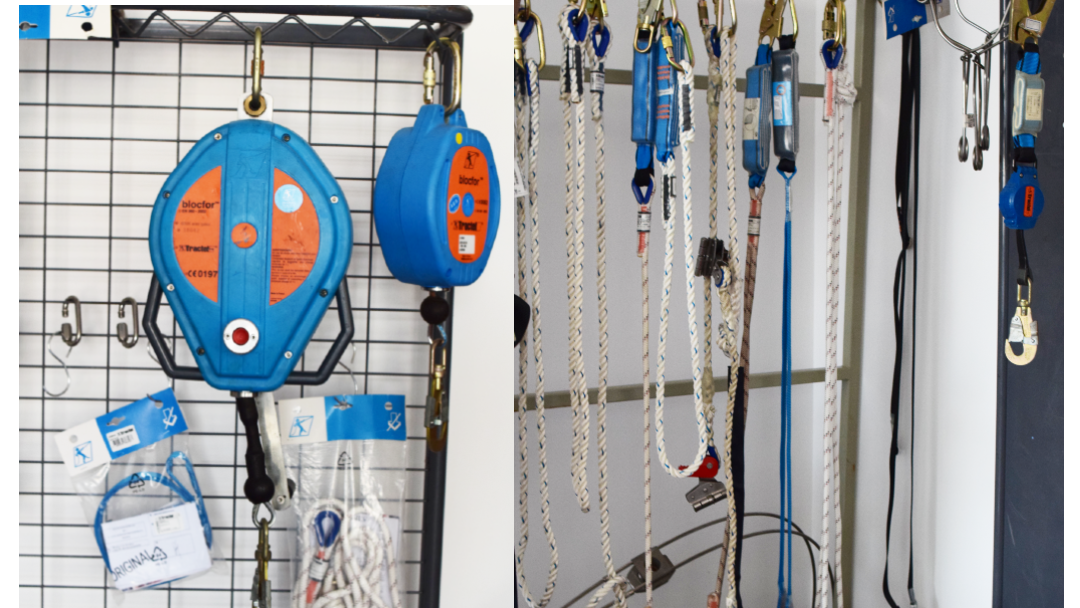In fall protection systems, Self-Retracting Lifelines (SRL) and Energy-Absorbing Lanyards are the two most commonly used — and most frequently confused — types of lifeline rope safety equipment. Both play a crucial role in preventing falls, yet they differ significantly in reaction speed, fall distance, flexibility, maintenance needs, and cost.
Understanding these differences is essential not only for proper equipment selection but also for ensuring overall lifeline rope safety performance and worker protection.
This article explores the five key distinctions between SRLs and safety lanyards, helping you choose the right solution for your work environment.
Basic Definitions
Self-Retracting Lifeline (SRL)
An SRL is a fall arrest device that locks automatically when a fall occurs, triggered by a sudden change in speed. It includes a retractable lifeline rope that extends and retracts with the worker’s movement, maintaining ideal tension and reducing the risk of tripping or slack. This mechanism is a core component of modern lifeline rope safety systems used in various industries.
Energy-Absorbing Lanyard
Also known as a shock-absorbing lanyard, this device consists of a rope or webbing line with hooks at both ends — typically one large hook for the anchor and a smaller one for the safety harness. It can be configured as a single hook or Y-shaped double hook to allow mobility between anchor points. During a fall, the energy absorber deploys to minimize the impact force on the user.
Difference 1: Fall Distance and Reaction Speed
SRL — Instant Lock and Short Fall Distance
SRLs engage automatically the moment a fall starts, limiting free fall to less than 0.6 meters (2 feet). Their rapid braking function enhances lifeline rope safety, especially in low-clearance or confined environments like factories, platforms, or rooftops.
Safety Lanyard — Shock Absorption with Extended Distance
A safety lanyard’s shock absorber deploys during a fall, typically extending 1.2 to 1.75 meters (4–6 feet) before halting the fall. This design provides effective energy absorption but requires sufficient clearance to operate safely.
Difference 2: Mobility and Working Flexibility
SRL — Retractable and Free-Moving
The SRL automatically retracts and extends as you move, maintaining consistent lifeline rope safety tension while allowing free mobility. It’s ideal for environments where workers need to move frequently between points at height.
Safety Lanyard — Fixed Length, Limited Range
Safety lanyards have a fixed length, usually 1.5–2 meters (5–6.5 feet), and do not self-adjust. They’re more suitable for vertical or static work positions, offering simplicity over flexibility.
Difference 3: Structure and Maintenance Requirements
SRL — Precision-Built and Long-Lasting
SRLs feature internal braking systems, gears, and retraction mechanisms, requiring regular professional inspection. Although initial costs are higher, their durability and reliability make them a long-term investment in lifeline rope safety.
Safety Lanyard — Simple and Easy to Maintain
A safety lanyard’s straightforward design requires only visual inspection and basic cleaning. It’s quick to replace and ideal for short-term or high-frequency construction tasks.
Difference 4: Application Scenarios and Environmental Adaptability
SRLs are best suited for vertical or horizontal movement in industries like wind energy, electrical maintenance, and manufacturing.
Their quick response ensures enhanced lifeline rope safety by minimizing fall distance and impact.
Energy-absorbing lanyards are better for short-term or fixed-point jobs, such as low-level maintenance or temporary installations.
While lightweight and affordable, they provide less flexibility than SRLs.
Difference 5: Cost and Lifecycle Value
SRL — Higher Investment, Better Long-Term Value
Though expensive upfront, SRLs can be recertified and reused, offering superior lifecycle value for safety equipment manufacturers and long-term users.
Safety Lanyard — Lower Cost, Quick Replacement
Safety lanyards are budget-friendly, ideal for bulk procurement or temporary projects. They provide an accessible entry point into lifeline rope safety systems for smaller teams.
Selection Advice
Choosing between an SRL and a safety lanyard shouldn’t depend solely on budget.
Consider the risk level, work frequency, and inspection cycle for your site:
If your work requires frequent movement, unpredictable fall height, or strict lifeline rope safety standards, choose an SRL.
If your environment is stable and budget-conscious, an energy-absorbing lanyard can be a practical option.
The right fall protection gear ensures both compliance and confidence — invest in what fits your real working conditions.
